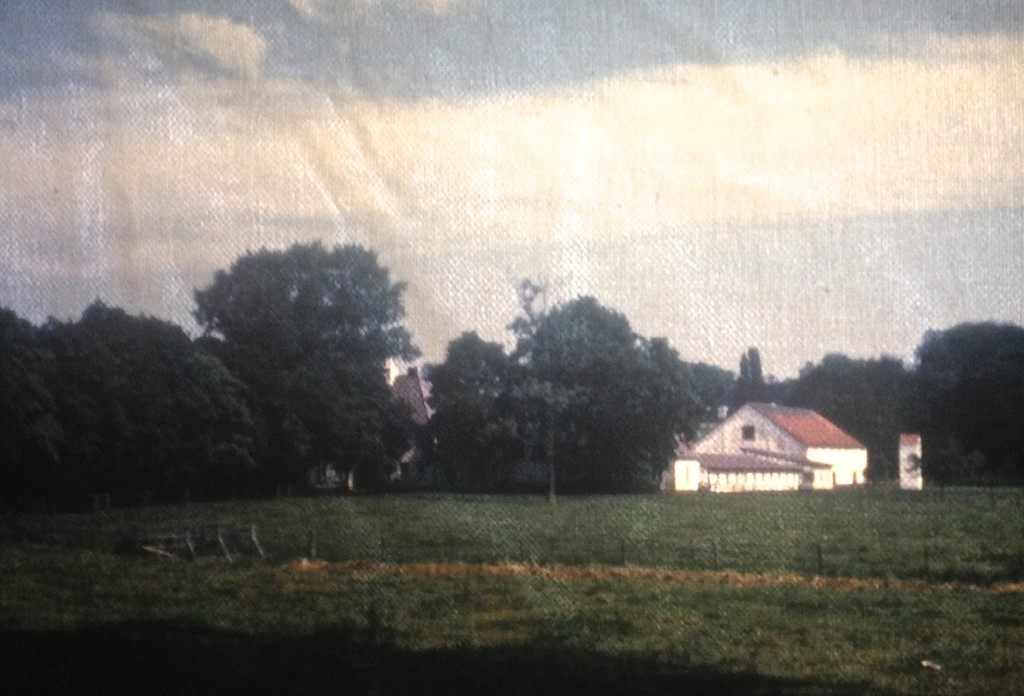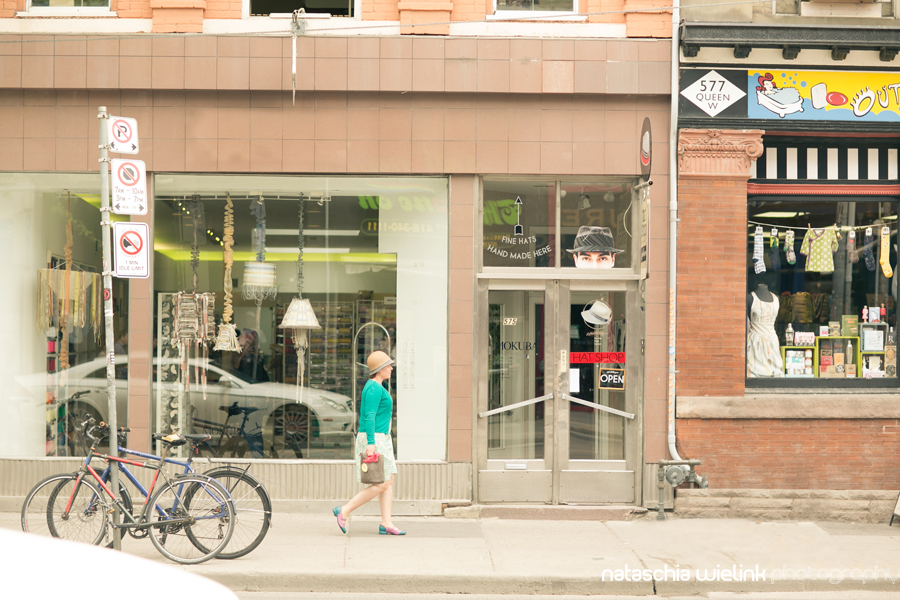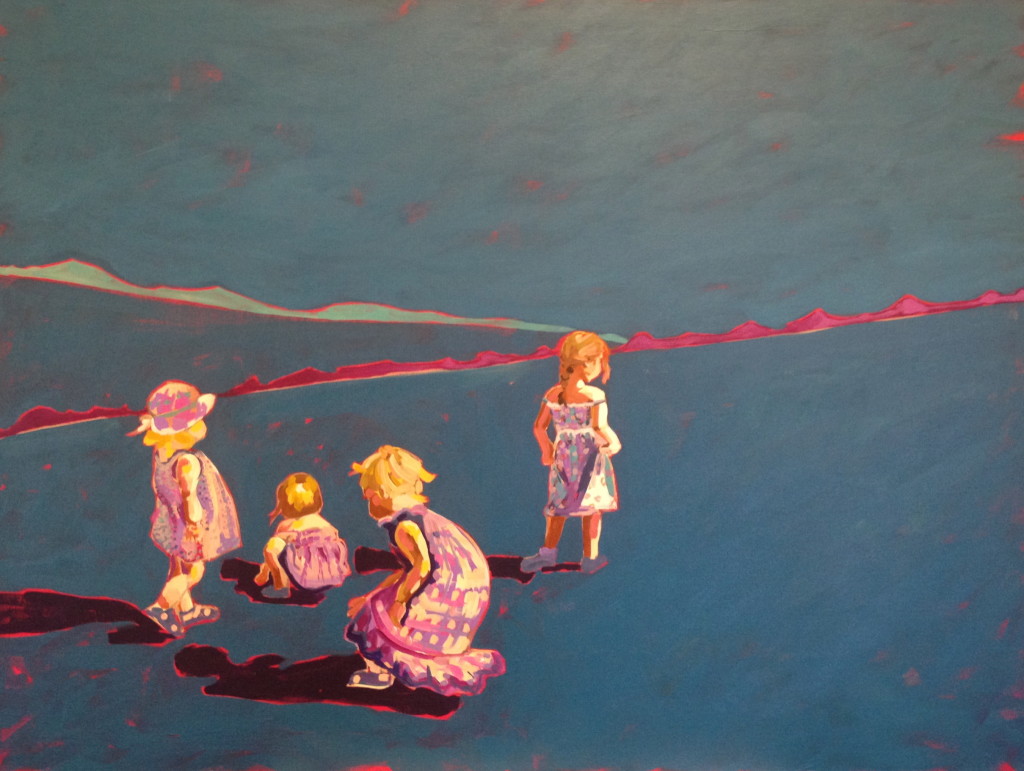
At a safe distance from the road, with a grassy pasture and a long curved drive acting as a soft buffer, there appears to be a quiet horse farm of little note or concern. Upon superficial inspection, it’s idyllic … a perfect property, almost certainly not harbouring any ghosts.
The Estate was called Rothensande which translates to “Red Sands”. Upon arrival, I realized my mother had been here before. She’d taken a photo of this property on a visit to Eutin in the 1960’s. I had a copy of the photo on my phone. Up until that moment, I had thought the photo was of “nothing” – just a farm property of little consequence, a scenic place along the road she passed by when she was a kid. I had totally dismissed it.
Standing in the centre of the estate, reflecting on my mother’s description of this place, I was struck by a rather ominous feeling. She had said, “there were unhappy happenings” here. I’d never known what those words meant until I was standing in the same place as she had stood to capture her photograph. Then I “knew” without a doubt that she had taken that picture as more than just a memory.
She was dealing with ghosts from her past.
You’d have to know my mother to know what I knew. Let me try to explain. She was never one to let rules or formal barriers get in the way of a good picture. I’ve seen her climb over fences, trample into people’s yards and even stand on the edge of a steep cliff (with certain death at the bottom) – just to get “the shot”. She’d been hissed at by snakes and fallen down in craggy rocks, yelling “oooohhh!” all the way back, her knees bleeding, but she got that picture of the desert rose by the cactus – and it’s beautiful. She’d even climbed through an electric fence to get farther back, trying to get the whole view of an alpine mountain into the frame of her camera. She would do just about anything or go anywhere to accomplish want she had on her mind.
Yet, for this picture, she didn’t get close at all.
The estate is in the distance. Small-looking. She could have climbed over the fence or gone down the drive just a bit to get a better vantage point if she’d wanted to. There were any number of ways to get a better picture. She didn’t even get the name of the estate in the frame – just a few buildings in the far-off distance. Not even a small attempt to get a picture of the big house which she lived in for a short time.
What I imagine, is a woman, so haunted by the ghosts of a place, that she dared not get any closer. She took a quick snapshot and kept on her way.
Not so long ago, Rothensande was an orphanage, but it has lived many lives both before and after that time. Perhaps most famously, in the 1950’s, (post-orphanage era) the property was used as the set for filming the “Gut Immenhof” series of movies – you might look at these films as the German equivalent of our Anne of Green Gables films. Rothensande was, and still seems an ideal piece of heaven, built for the purpose of luxury and enjoyment. Such was not my mother’s experience when she stayed there for a short time in 1948.
I can only speculate now what those “unhappy happenings” were, but I do think it had my mother pretty rattled, emotionally speaking. So, now, when I think of her going back to that place called Rothensande, I see a broken woman, still sorting through a whole package of emotions. I imagine her circling back to the orphanage, not out of curiosity or fond feelings … but just to “deal’ with it.
I happened to talk to the man who runs the estate now. He said, from time to time, he hears stories from people who used to live there … former orphans who were sent off to South Africa and Canada. He relayed their tales of abuse and punishment to me. If there were any happy stories to tell, he didn’t hear them and he didn’t share any with me. My mother said the couple who ran the orphanage were “strict”. I also know that my grandmother, lying in her hospital bed a few months from death, went to great lengths to get my mom out of the orphanage quickly. She, a Mennonite, even converted to Catholicism in an attempt to get a local Catholic family to adopt her daughter.
The orphanage had everyone rattled.
I can’t imagine anyone in this world more helpless than a child without a parent. As I was at Rothensande on a tour (they now give tours of the estate on Wednesdays and Saturdays, for the many fans of the Gut Immenhof Films) I noticed, among the group of people, several small children. They had parents but as the children went off to play on their own, separating from the group, they began to look like orphans to me. I kept my distance and observed their innocence as they poked at the dirt and puddles in the pathway. Without a parent or anybody who cared even just a tiny little bit, these children were like sitting ducks, vulnerable to the slightest abuse. I remember when I was a child, how I relied on the adults in my life to care for me – I believed they had my safety and well-being in mind. That’s what makes children so beautiful and precious. Their blind trust and unspoiled attitude toward life should be guarded by the people around them.
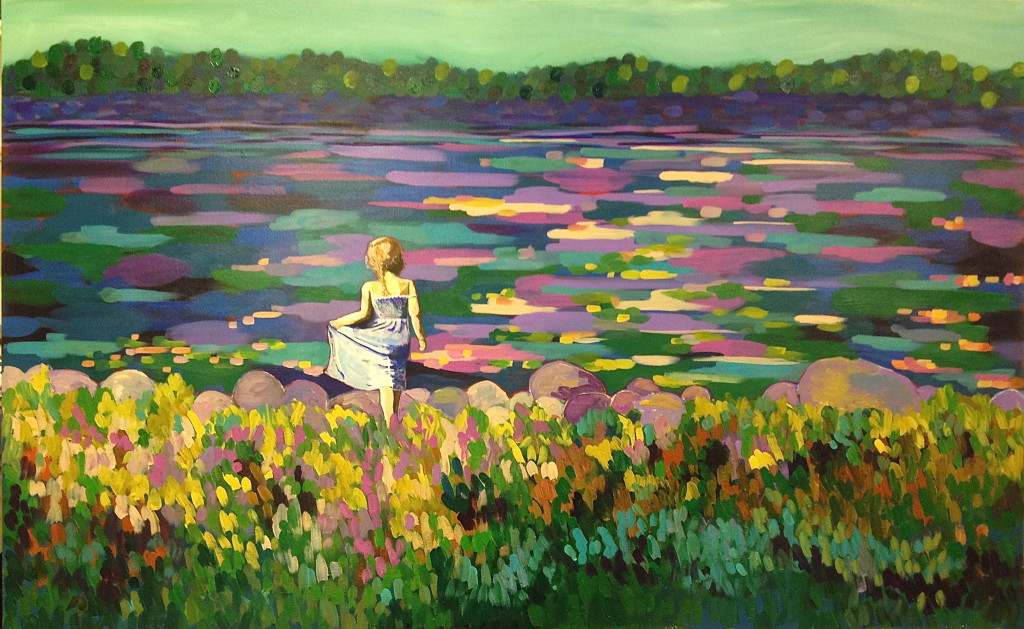 As I watched the children at Rothensande, all I could hear were my mother’s words … “unhappy happenings”. I saw the truth right in front of me. My heart broke a little bit for her. I wanted to rush in and protect her from the pain of loneliness or abuse … or whatever happened at the orphanage, which I will never know.
As I watched the children at Rothensande, all I could hear were my mother’s words … “unhappy happenings”. I saw the truth right in front of me. My heart broke a little bit for her. I wanted to rush in and protect her from the pain of loneliness or abuse … or whatever happened at the orphanage, which I will never know.
I took some photos of the children as they played in the dirt. A girl, who I guessed to be about 8 years old, walked over to the water with a small stick in her hand. She had a long braid of red hair and a sun dress with one strap fallen off her shoulder. She intrigued me. I imagined she was my mother over 60 years ago.
Careful not to get caught, I photographed the little girl in the sundress, so I could remember the moment and all of the emotion that went along with it. I’m quite certain if her parents saw me stalking their daughter, it would’ve been a messy scene. But I wanted the shot … and so I took the risk.
Months later, I painted that little girl. She is looking out to her imaginary world on the water. As colourful brushstrokes danced on canvas, I thought of my mother and all the other orphans and all of their stories.
They were beautiful, innocent, vulnerable and lonely.
Rothensande was an interesting experience for me. It’s a place that opened my eyes and my heart to see my mother’s story in more than just black and white. For that, I’m thankful.
————————————————————————————————————————————
If you’re interested in seeing some Rothensande pictures backed by the Gut Immenhof soundtrack, take a look at the video below!
————————————————————————————————————————————
Stories a property holds onto, buried under red sand, afloat on blue water or tucked away behind decades of floral wallpaper, layered on layers, will only ever be a kaleidoscope time capsule; fragments and flashes of colour without much order or sense; a curiosity to turn round and view from time to time.
————————————————————————————————————————————
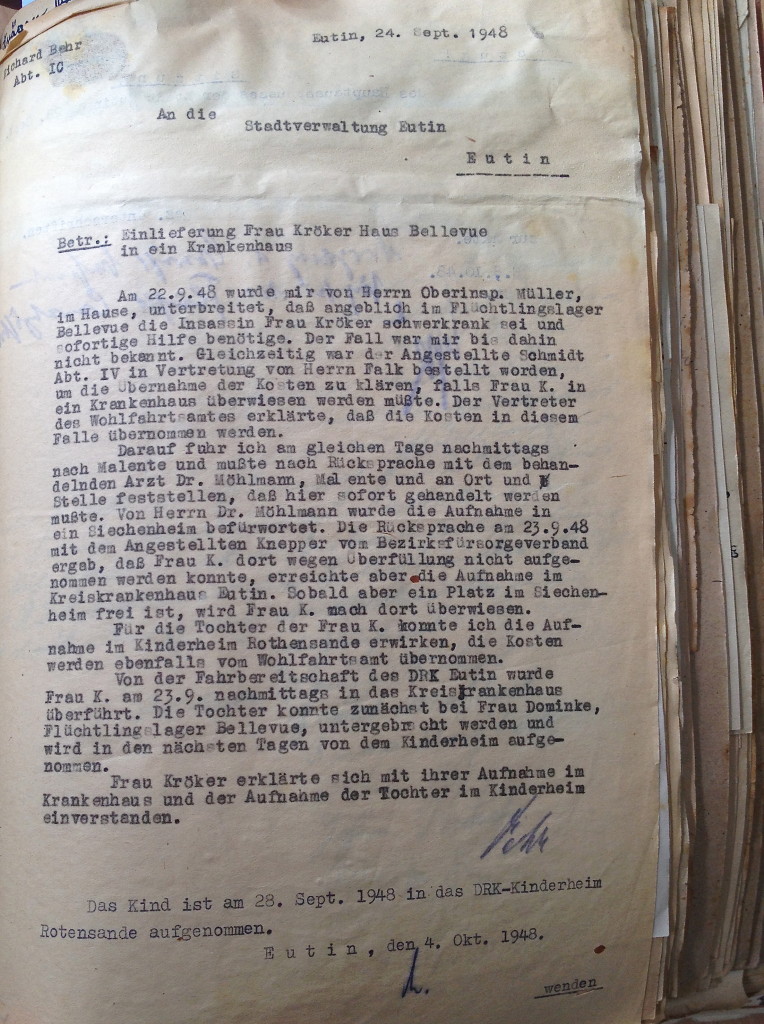
A few days before visiting Rothensande, I had been searching through a series of giant books in the Eutin Archive for many hours, desperately scanning each page for two names, Monika Kröker or Maria Kröker. I was looking for any clue, no matter how slight, to unlock stories about my mother’s and grandmother’s lives from the time when they lived in Eutin and surrounding area. They were there during the influx of refugees and displaced persons (DPs) in the time after WW II. In the town of Eutin alone, the population doubled from 10,000 to 20,000 people in a matter of months in 1945. Searching in the DP-related archives was tedious work; many hours are spent for little to no reward. These documents were typed or hand-written in every size and style of paper – all in German – a language that, for the most part, I don’t understand.
As I turned another page in the mountain of pages, there was a letter dated Sept 24, 1948 with my grandmother’s name in the subject line. I gasped out loud. This was the clue I’d been hoping to find. The letter was lengthy and roughly explained the reasoning for relocating my mother and grandmother from their current dwelling: My grandmother needed to go to a hospice on account of being very ill and my mother (having nowhere else to go to and no one to care for her) was sent to an orphanage. This letter told me the name of the orphanage I’d been hoping to track down. “Rothensande”, a very pretty name which means “Red Sands”.

